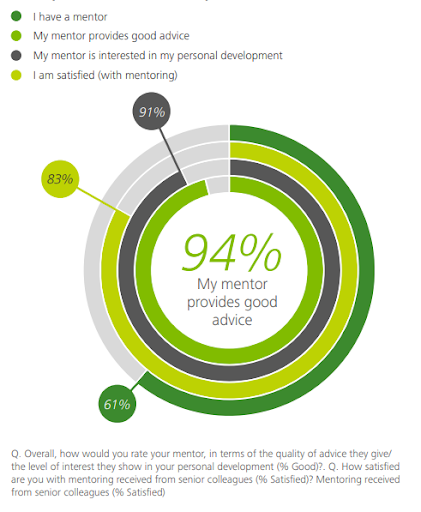What is Peer Mentoring and Why Should Startups Care?
Startups can struggle to onboard new hires quickly and effectively because they may not have the necessary resources in place. Peer mentoring can help fill this gap by providing a way for more experienced employees to share their knowledge with newer staff members.
In this article, GrowthMentor will be explaining exactly what peer mentoring is and why startups should care about implementing such a program within their organization.
Let’s get started!
What is peer mentoring?
Peer mentoring is a learning and development process that connects two people who are similar with regard to a defining characteristic (e.g., expertise, industry background, etc.), but have different levels of experience in some key areas.
Peer mentoring in the workplace generally refers to a more experienced employee taking a less experienced employee (of a similar age) under their wing to provide guidance, support, and advice.
The goal of peer mentoring programs is to help employees grow—both personally and professionally—through skill transfer, knowledge sharing, and mutual support.
What about peer mentoring for founders and executives?
New hires and junior employees aren’t the only ones who can benefit from peer mentoring. According to a study of successful tech founders by TechCrunch, having a peer mentor was one of the best predictors of eventual success in your industry.
The study highlights a number of influential peer mentor relationships, including Caterina Fake (Flickr) and Chad Dickerson (Etsy), as well as Brian O’Kelley (AppNexus) and Nat Turner (Flatiron Health). Long story short, peer mentorships are both common and effective among founders.
At GrowthMentor, we help entrepreneurs, founders, and marketers make these kinds of connections with experienced mentors from companies like Piktochart, IBM, Baremetrics, and Typeform.
You can book one-time calls for targeted advice in areas like bootstrapping, product market fit, and link building, or become a member for unlimited calls with a wide range of expert peers!
Why should startups care about peer mentoring?
There are a number of reasons why startups should care about peer mentoring, but here are six of the most important:
- Quick and effective onboarding
- Increased employee engagement
- Increased employee retention
- More seamless successions
- Improved team performance
Let’s take a closer look at each of these.
1) Quick and effective onboarding
One of the biggest challenges for startups is onboarding new employees quickly and effectively. A study by the Society for Human Resource Management found that it takes an average of one year for a new hire to become fully productive—and that’s if they receive high-quality onboarding!
If you’re not able to onboard your employees effectively, you run the risk of losing them entirely. In fact, one study found that 30% of employees who didn’t receive adequate onboarding begin looking for new jobs within their first 180 days on the job.
That’s where peer mentoring comes in. By pairing new hires with more experienced staff members, you can help them assimilate to company culture more quickly and effectively. Furthermore, research has shown that peer mentoring can lead to a more positive onboarding experience for employees.
2) Increased employee engagement
Employee engagement is an important predictor of both individual and team performance within a startup. Unfortunately, employee engagement rates are hitting historic lows in the U.S. and around the globe. Peer mentorship programs may be an effective solution to this problem.
According to a survey from Gallup, there are five leading factors causing employee disengagement. As luck would have it, all of these factors can be improved by implementing a peer mentorship program:
- Lack of Training and Development: Peer mentoring can help employees feel like they are constantly learning and growing, which is a key driver of engagement.
- Lack of Communication: A mentor can help a mentee feel more connected to the organization by sharing important company news, updates, and insider knowledge.
- Lack of Advancement Opportunities: A mentee can use their mentor as a sounding board for career aspirations and goals.
- Lack of Accountability: Mentors can help new hires develop a sense of personal accountability within the organization by checking in on progress towards personal and professional goals.
- Lack of Social Ties: Peer mentorship programs allow employees to connect with their peers in ways that go beyond the standard colleague relationship.
By killing five birds with one stone, peer mentoring can help give startups a competitive edge when it comes to improving employee engagement.
3) Improved employee retention
High employee turnover rates can be costly for startups—both in terms of money and time. A peer mentorship program can help reduce turnover by creating a support system for new employees that sets them up for success.
One study from Deloitte found that 83% of employees who had a mentor reported feeling satisfied in their roles. That’s a significant number for startups—especially compared to a 65% satisfaction rate in employees who didn’t.
There are a few reasons why peer mentorship programs help reduce employee turnover. The simplest of these is that employees who feel connected to others in their organization are less likely to leave.
Studies consistently show that employees with one to five friends at work are 60% less likely to quit than those without—and a peer mentor fills that need nicely.
4) More seamless successions
Gallup estimates that leadership and talent vacuums resulting from voluntary turnover cost U.S. businesses around $1 trillion every year. Recruiting, hiring, and training new talent takes time and resources. Plus, every day the position isn’t filled means an organization is working at less than 100% of its capability.
A peer mentorship program can help alleviate some pressure associated with succession planning by preparing employees for leadership roles within the organization.
Mentees can shadow their mentors, learn from their experiences, and gain the skills and knowledge needed to step into a leadership role when the time comes. And because mentors and mentees already have a relationship built on trust, the transition will be smoother for everyone involved.
5) Improved team performance
The benefits of peer mentorship programs extend beyond the individual level—they can also have a positive impact on team performance.
Mentees who feel supported by their peers are more likely to take risks, which can lead to innovation and creativity. And when employees feel like they are part of a cohesive team, they’re more likely to go above and beyond for the good of the group.
In one study, teams that underwent a peer mentoring program saw significant improvements in team performance, including:
- Increased task completion rate
- Improved quality of work
- Greater efficiency
- Enhanced creativity
These are all improvements that have the potential to benefit any startup.
How to start a peer mentoring program
If you’re convinced that peer mentoring is something your startup should be doing, then you’re probably wondering how to get started.
Here are six simple steps you can follow to get a successful program off of the ground:
1) Define your goal
Before you can start a peer mentoring program, you first need to define its goal. That means thinking about the organizational and interpersonal results you’d like to see from the program. While there are essentially infinite possibilities, some common peer mentorship goals include:
- Quicker onboarding
- Reduced employee turnover
- Improved team performance
- Deeper social connection
- More inclusive spaces
Your program could be built around one central goal or multiple goals—it all depends on what’s most important for your organization.
2) Get buy-in
Getting buy-in from senior employees and company management is essential for any peer mentorship program. These are the people who will be providing the resources and support the program needs to be successful.
How do you go about getting buy-in? Here are three steps to follow:
- Start by conveying the benefits of peer mentoring (like the ones we listed above).
- Then, share your vision for the program and what you hope to achieve.
- Finally, make a case for why your company is uniquely positioned to make the program a success.
One-on-one meetings are the best way to get buy-in because they allow you to tailor your message to the person you’re speaking to.
3) Start recruiting participants
Once you have buy-in from senior employees, it’s time to start recruiting participants for your program. The best way to do this is to reach out to employees who you think would make good mentors and mentees.
When making your selections, look for employees who are:
- Highly engaged with their work
- Able to build strong relationships
- Committed to personal and professional development
- Open to feedback
It’s also important to make sure that there is a good mix of seniority levels, departments, and backgrounds represented in the program. This will help ensure that you’re able to match mentees with their “peers”—however, you decide to define that word within your program.
Note: For high-level positions, it might not be possible to find internal peer mentors. That’s where platforms like GrowthMentor come in! We connect your startup with external peer mentors who have the experience necessary to teach at any level.
4) Pair participants up
Once you have a list of participants, it’s time to start pairing them up. The best way to do this is to create a mentee profile that includes information about their goals, interests, and experiences. You can then use this information to match them up with a mentor who can help them achieve their goals.
It’s important to note that not all pairings will be perfect—and that’s okay! The point of peer mentoring is to provide employees with access to new perspectives and ideas, not necessarily to find participants their new best friend!
5) Launch the program
Once you’ve recruited participants and paired them up, it’s time to launch your peer mentoring program! To get started, have each mentor-mentee pair schedule an initial meeting. This meeting can be used to discuss the goals of the program and set expectations for how the relationship will work.
After the initial meeting, it’s up to the mentor and mentee to decide how often they meet and what format their meetings will take. Some pairs prefer to meet on a weekly basis, while others meet monthly or even quarterly. There is no right or wrong answer here—it all depends on what works best for the individual pair.
6) Evaluate, assess, and adjust
Last but not least, it’s important to evaluate your peer mentoring program on a regular basis. This will help you identify what’s working well and what could be improved.
One way to evaluate the program is to ask participants to fill out a survey at the end of each mentoring cycle. You can also conduct interviews or focus groups to get qualitative feedback. Based on the feedback you receive, don’t be afraid to make adjustments to the program.
Remember, peer mentoring is all about trial and error—it’s unlikely that you’ll get everything right on the first try. But as long as you’re willing to learn and adapt, you should be able to create a program that provides real benefits for your organization.
Starting a peer mentoring program
Peer mentoring is a great way to provide employees with access to new perspectives and ideas. It can also help foster relationships between employees of different seniority levels, departments, and backgrounds.
If you’re thinking about starting a peer mentoring program at your organization, following the tips and steps outlined above will help you get it off the ground without a hitch.
And if you’re a founder, owner, or marketer looking to connect with mentors from companies like Amazon, PandaDoc, and Uber, GrowthMentor is here to help! Start browsing mentors today and make connections that help you reach your full potential.





